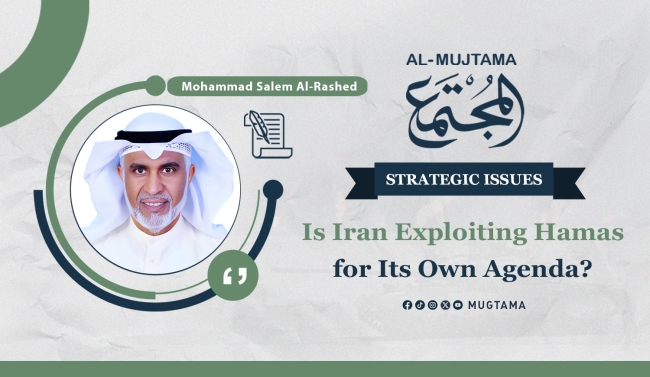Is Iran Exploiting Hamas for Its Own Agenda? Featured
I read two articles yesterday: the first is a Special Study on the “Ourouba 22” website by Dr. Muhammad Rumayhi, a liberal Kuwaiti professor and writer who does not criticize normalization, and the other by Mohanna Al-Hubail, a Saudi Islamic writer opposed to normalization who published his article on his “X” account.
Both articles, without delving into details, blame the actions of “Hamas,” viewing the event from the perspective of gathering information and data based on predetermined, biased, and unfair positions.
Both writers agree that the October 7 battle is a strategic investment for the Iranian project, and “Hamas” is merely executing it.
However, prominent “Hamas” leaders in several interviews have denied that all parties, including their political leadership, were aware of this move.
Unfortunately, analyzing the strategic situation in this war and its outcomes from a singular, pivotal perspective is flawed and restricted by preconceived accumulations and specific positions. It often involves overlooking the course of events, distorting facts, and twisting statements to fit pre-arranged judgments. This only reflects the crisis of sovereign thought among Arab elites. Who among us does not know and has not followed the Iranian project, its dangers in the region, and its strategic successes? I wrote a comprehensive study in 2012 on the Iranian project, its dangers, and the opportunities available to contain it, not to mention the hundreds of studies and articles by Arab writers in this field.
But the roots of the Iranian project's success began during the Iran-Iraq war and its repercussions on the region, followed by Saddam Hussein's invasion of Kuwait.
When Kuwait was liberated, Gulf states and some Arab countries joined a US-Western international alliance to achieve this goal. The justification at the time was a significant interest that involved bringing foreign forces into the region and securing them through security agreements. Had this effort solely focused on liberating Kuwait, it would have been a resounding success for this strategic policy. Gulf states and other Arab countries could have contained Saddam's Iraq instead of engaging in toppling a regime that was already weak after the liberation of Kuwait. This would have at least maintained a strategic balance with Iran. However, the region's countries got entangled in the American-Israeli scenario, with Iran looming behind the scenes.
Handing Iraq over to Iran, coordinated with the United States, was catastrophic. It shifted the security equation in the region between Iran, the United States, and Israel, removing Iraq from the power balance equation and making Iran a threat to the region. At that time, “Hamas” was not aligned with either authority or an Iranian alliance to fit the claims of the aforementioned two writers regarding Iran's investment in “Hamas.”
The rest of the story is well known: Syria, Lebanon, and Yemen were handed over to the Iranians, serving as barriers threatening the Sunni component and its states. Iran has thus created a constant state of balance and restlessness for the region's countries, paving the way for normalization agreements with Israel.
The Arabs failed themselves by not supporting the Syrian revolution to overthrow Bashar's regime. In reality, “Hamas” is not providing Iran with true progress or strategic support.
The late Iranian Foreign Minister, Amir-Abdollahian, mentioned in his final book, “Syria Morning,” that he attended the inauguration of an Arab president. During this visit, a former foreign minister delivered a message from this president, requesting gratitude be conveyed to the Iranian Supreme Leader and leadership. The message emphasized that the state would not align with the Gulf and Western countries regarding their stance on Bashar al-Assad, refusing their requests to condemn Iran's nuclear project and support Bashar al-Assad!
Hamas is a popular resistance movement seeking to liberate Palestine and restore the usurped rights of the Palestinian people, which the “Oslo Accords” failed to achieve with Arab, Gulf, and international support. Israel has occupied all of Palestine, from Jerusalem to the West Bank, leaving only Gaza as a liberated area under the control of the Palestinian resistance.
The question is: How can Hamas, as a legitimate resistance movement, survive amid conflicting and diverging alliances with differing interests and goals, especially with zero Arab support for “Hamas,” either out of desire, fear, or submission to American policies in the region?
Here is the Arab-Israeli blockade on Gaza since 2007, and there are normalization agreements initiated by Israel with Arab countries, removing these countries from the conflict with Israel. These agreements have also launched a new era of supplying Israel with its needs, trade, and growth, and even extending its strategic vision in the region.
There is also the daily Israeli brutality against the Palestinian people and the ongoing war on Gaza since 2007 until this day, as well as the international isolation of “Hamas” and the Palestinians and daily violations of human rights and international law.
Therefore, the strategic policy of “Hamas” in fulfilling its duties towards its people is determined by its own assessment of its position. “Hamas” is the owner of the land and the people in Gaza, along with the other factions and popular blocs that have found no ally except by forging possible and available alliances to face the fierce war waged by the Zionist entity, backed by American support, Arab betrayal, and Israeli savagery.
It is natural that when there is an opportunity to cooperate with an axis that supports the resistance and enhances its capabilities in managing the political, military, and economic struggle, “Hamas” finds no option but to align with Iran. This cooperation only emerged after the Gaza blockade in 2007. The decision and the assessment of the situation are not based on what the Iranians think of their project; it is their project, and they naturally work on it with intelligence and patience to extend their interests and power in the Arab region. However, the decision of “Hamas” is determined by legitimate and realistic interests, and Sharia is about seeking benefit or avoiding harm.
It is about prioritizing the greater benefit over the lesser one, or avoiding the greater harm for the lesser one. This falls within the framework of Sharia politics, which involves assessing the situation and taking political, military, and economic measures that achieve the least harm and the greatest benefits.
And the question remains: Did Hamas have any refuge or place it could turn to since 2007? What were its options?
Should it have entered the “Oslo Accords” that Abbas's rule has succeeded in nothing but entrenching the occupation’s control over the West Bank? Or should it have joined the normalization agreements, which established Zionist control over the region? Or should it have aligned with the Arab regimes that decided to end the Palestinian cause through normalization in exchange for a non-viable, disarmed Palestinian state?
The price of liberation from the Israeli occupation must be paid. History shows that nations have been freed through millions of martyrs, war, and the destruction of infrastructure. “Hamas” cannot prevent Iran, the United States, the Zionist entity, or the Arab regimes from exploiting the ongoing conflict—this is beyond its control. Thus, “Hamas” aligned with the Iranian axis, which champions resistance, as it was the available option for survival and for keeping the Palestinian cause alive in the world, as witnessed after the “Al-Aqsa Flood.”
Therefore, the solution is for Arab regimes to awaken from their strategic and religious coma and unify ranks to confront not just Iran but also potential conflicts in Lebanon and a possible coming world war, whose outcomes could spell the end for the Arabs. As mentioned in the Hadith, “Woe to Arabs because of evil which has drawn near!” There is no use of blaming “Hamas” for the strategic mistakes of the Arab regimes over the past decades.
This is a war imposed on Palestinians since the British occupation of Palestine and its handover to the Jews in 1948. “Hamas” is not different from the movements and fighters in Palestine since the 1920s. Criticizing “Hamas” and the people of Gaza in these moments is a mere absurdity that only serves the interests of the Zionist entity and bolsters Iran’s position.
Conclusion
Iran's expansion in the Arab region and its occupation of geographical areas have been facilitated by the strategic policies of some Arab regimes, who were deceived by American promises and Zionist machinations. “Hamas” has nothing to do with Iran's expansionist project. Major countries like Russia and China strategically support Iran, while others, like the United States and the European Union, negotiate with it. Some clash with it according to the rules of conflicts, such as the Zionist entity and some Gulf states.
So, have the Arabs ever considered how to solve their issue with “Hamas” and unify their strategies toward Palestine?
-------------------------------------------------------------


